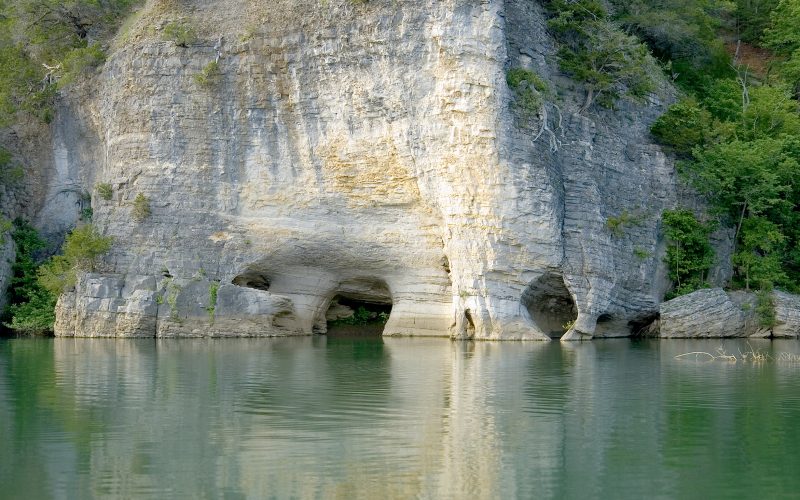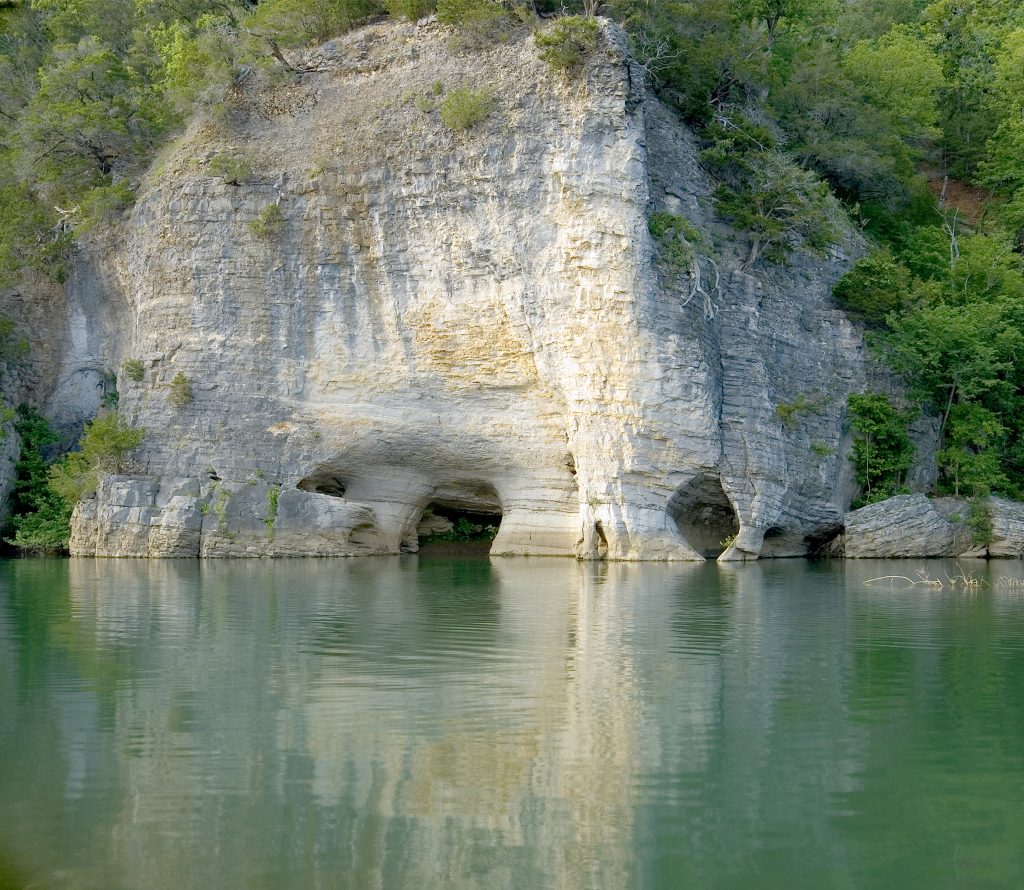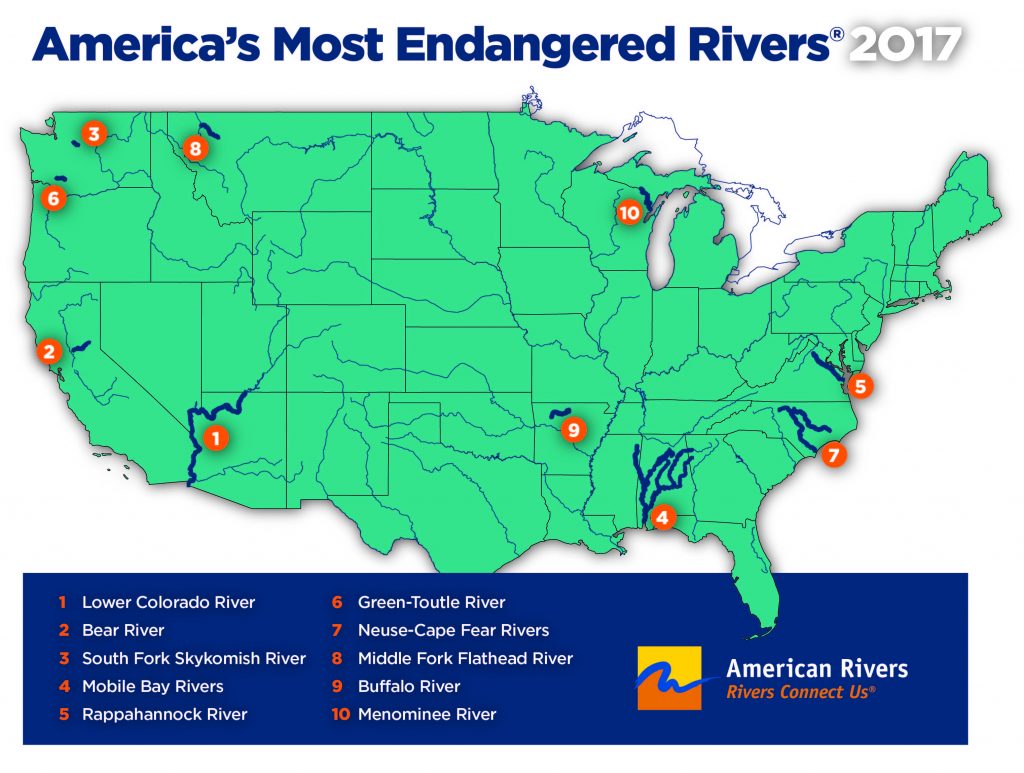- Courtesy Photo/ Angela Peace / The Buffalo National River, the first national river, is No. 9 on American National Rivers’ list of endangered rivers.
A national report ranked the Buffalo National River in northern Arkansas among America’s most endangered rivers Tuesday, citing concerns about a nearby large hog operation’s waste polluting the river.
In the report by American National Rivers, a river preservation advocacy group, the lower Colorado River was ranked the most endangered river on the list, and the Buffalo National River is No. 9 on the list. Rivers are chosen for the list based on the magnitude of the threat, the significance of the river to people and nature and how near a critical decision-point is in the coming year.
Following the publishing of the report, American National Rivers and its partners called on the Arkansas Department of Environmental Quality (ADEQ) and Gov. Asa Hutchinson to deny C&H hog farm’s operating permit renewal in order to safeguard clean water, the regional natural heritage and the river’s economic value.
“The America’s Most Endangered Rivers report is a call to action to save rivers that face a critical decision in the next year,” said Matt Niemerski, Director of Federal Policy for American Rivers. “Millions of gallons of animal waste are threatening the Buffalo National River, which is supposed to be protected for all Americans to enjoy. Now is the time to speak up to make sure decision makers uphold their responsibility to safeguard this special place for today’s communities and future generations.”

The Buffalo National River
C&H HOG FARM CONTROVERSY
The Buffalo, the first national river, runs 153 miles through the Ozark natural forest in northern Arkansas. C&H hog farm, a confined animal feeding operation (CAFO), sits five miles from the edge of the Buffalo River near Big Creek and nearby to the Mt. Judea school. About 80,000 pigs a year are processed, and the operation generates waste equivalent to a city of 30,000 people. To manage the waste, the CAFO utilizes a nutrient management plan that involves spraying millions of gallons of liquid hog waste onto pastures and fields for fertilization, some of which lie in the floodplain.
Water quality indicators, including an unprecedented algal bloom in 2016, E. coli bacterial concentrations exceeding allowable limits and dissolved oxygen concentrations below allowable limits, suggest the Buffalo National River and its fish and wildlife are being negatively impacted by the nutrients produced by the CAFO.
“Last year’s huge algal bloom was further evidence of the Buffalo National River’s declining water quality caused by excessive agriculture run-off,” said Teresa Turk, co-founder of Ozark River Stewards. “It was heartbreaking to see and document.”
The fields that are used to spray the waste to fertilize the fields are believed to be located atop karst geology — which means the land has a thin topsoil above very porous rocky (in this case chert and limestone) ground — and would be unable to handle the amount of nutrient spray to properly filter the toxic bacteria from the manure in the soil. In a karst environment, ground water moves rapidly alongside surface water, and can be difficult to predict how and where it flows. So, there is concern that the waste being sprayed near Big Creek could seep into the ground water and pollute the Buffalo River, which is a federally preserved river.
“Nonpoint source impairment will continue to pollute American waterways until we recognize that concentrated animal feeding operations are actually concentrated animal waste operations that produce more untreated sewage than most ecosystems can handle,” said Lin Wellford, one of three grandmothers involved in a legal appeal for the so-called ‘permit to pollute’ the Buffalo National River watershed. “In the case of regions with fragile karst geology (a porous limestone), the impact of these industrial-scale operations is particularly devastating.”
However, the hog facility has been approved for all necessary permits by ADEQ to operate. In an environmental assessment, the two agencies that conducted it — the Small Business Association and Farm Service Agency — denied that the hog farm and its NMP fields sit atop karst geology.
A few independent studies led by UofA hydro-geologist Van Brahana claimed the agencies were incomplete assessments that only considered surface water.

Courtesy Photo/ Carol Bitting
An unprecedented algal bloom in 2016, E. coli bacterial concentrations exceeding allowable limits and dissolved oxygen concentrations below allowable limits suggest the Buffalo National River and its fish and wildlife are being negatively impacted by the nutrients produced by the CAFO.
THREATS TO RIVER STATUS
Alice Andrews, Conservation Chair at the Ozark Society, said she fears if faced with inaction, the Buffalo River will be placed on the 303(d) list of impaired streams under the Clean Water Act and EPA.
“I fear that sooner or later, if nothing is done about this CAFO, the magnificent Buffalo National River will no longer meet its designated use as ‘fishable/swimmable,’” she said, “and will lose the extraordinary resource values that led to its designation as a Wild and Scenic River, an Extraordinary Resource Water and an Outstanding National Resource Water.”
The Buffalo National River is one of the few remaining undammed rivers west of the Mississippi. It was designated as the nation’s first national river by Congress in 1972 to preserve its clean water and other outstanding values. The National Park Service is charged with managing the Buffalo River to, “preserve, conserve, and interpret a clear, clean, free-flowing river and its Ozark Mountain setting of deep valleys, towering bluffs, wilderness and pastoral landscapes.”
“As we approach the 50th anniversary of the Wild and Scenic Rivers Act in 2018, we must recommit ourselves as a nation to uphold safeguards for the Buffalo National River, and all federally protected rivers,” said Niemerski.
BUDGET CUTS
The report comes on the heels of proposed budget cuts to the Environmental Protection Agency and National Parks Service from the Trump Administration that will likely further complicate conservation efforts.
The Buffalo National River managers have felt the impacts of budgetary restriction for a number of years, causing staff shortages, which limit the ability of park biologists to monitor water quality and maintain the many campgrounds and access points along the river. The proposed 12 percent budget reduction for the National Park Service comes as tourism numbers approached record highs last year. In 2015, more than 1.46 million tourists visited the Buffalo National River generating $62 million and employing more than 960 people from tourism related activities.
Projected cuts of nearly one-third of the overall budget for the EPA pose a threat to river preservation efforts. These cuts to resources and staffing will make it harder to enforce current water safety standards that ensure clean water for recreationalists and protections for endangered species that depend on a healthy environment for their existence.
“We will continue to fight to rid the Buffalo National River watershed of the threat of potentially devastating pollution that is presented by the presence of the hog farm,” said Gordon Watkins, President of the Buffalo River Watershed Alliance.
Headquartered in Washington, D.C., American Rivers has protected and restored more than 150,000 miles of rivers through advocacy efforts, on-the-ground projects, and an annual America’s Most Endangered Rivers campaign since 1973.
For more information about about Buffalo River preservation efforts, visit www.buffaloriveralliance.org, the Buffalo National River Partners at bnrpartners.org or the Ozark River Stewards Facebook page. The Ozark River Stewards will be hosting a Float Protest over Memorial Day weekend, with details to be determined.
America’s Most Endangered Rivers® of 2017:
#1: Lower Colorado River (Arizona, California, Nevada)
Threat: Outdated water management and excessive diversions
#2: Bear River (California)
Threat: New Dam
#3: South Fork Skykomish (Washington)
Threat: New hydropower project
#4: Mobile Bay Rivers (Alabama, Georgia, Mississippi)
Threat: Poor water management
#5: Rappahannock River (Virginia)
Threat: Fracking
#6: Green-Toutle River (Washington)
Threat: New mine
#7: Neuse and Cape Fear Rivers (North Carolina)
Threat: Pollution from hog and chicken farms
#8: Middle Fork Flathead River (Montana)
Threat: Oil transport by rail
#9: Buffalo National River (Arkansas)
Threat: Pollution from massive hog farm
#10: Menominee River (Michigan, Wisconsin)
Threat: Open pit sulfide mining












